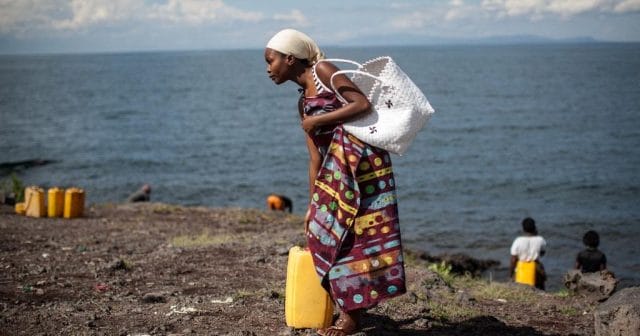DR Congo: Locals trek to Lake Kivu as volcano crisis cuts water supply

Following the volcanic eruption of Nyiragongo on Saturday in the eastern region of the Democratic Republic of Congo — which killed at least 32 people and caused about 5,000 to flee across the nearby border into Rwanda, the water supply has been cut off in large parts of Goma city.
As such, hundreds of locals who remain within the vicinity have no choice but to walk long distances from their homes to fetch water at Lake Kivu.
Bintu Aleluya Aline, a resident of the roughly 2 million-inhabited Goma, shares her experience of the current situation.
“I came here to the lake only to find out how to take water and prepare (things) for my children. We have taps at home but the water doesn’t flow anymore; if I don’t come here to the lake I would be forced to pay a lot of money, even 300 Congolese francs (0.15 US dollars) for 6 plastic containers of water.”
The volcano remains active and two cracks in the ground extending from the foot of Mount Nyiragongo to the city centre further frighten locals amid earthquake tremors.
Another Goma resident, Patrick Amani, is still feeling insecure about the state of things.
“We live in fear, we are too worried because we don’t know what to expect and we are living in a very difficult situation with the earthquakes that happen overnight. We don’t know what we are going to do. We are left to our own fate.”
Over 500 homes were destroyed in nearby villages by the lava from the volcano and 25,000 residents have since sought refuge in the northwest in Sake.
But the worst might be over as per Data gathered by The Volcanic Observatory of Goma.
Scientists at the volcano observatory weren’t able to adequately warn the public of the eruption because of a funding cut, the scientific director of the Volcanic Observatory of Goma, Celestin Kasereka Mahinda, told The Associated Press.
A partnership between the government and the World Bank that had supported the observatory was cut in October 2020 because of the coronavirus pandemic, leaving the observatory without even an internet connection, he said.
The observatory had just started to resume operations last month thanks to new funding from the U.S. Geological Survey’s Volcano Disaster Assistance Program, which means the observatory can at least gather data after the eruption.
Director Celestin Mahinda shares what could be considered a semblance of good news for the locals in the region.
“For the current state of the volcano, we say that the lava flow is no longer progressing and we ask the population to stay away from this lava flow, it is very dangerous.”
Over 170 children are still feared missing as UNICEF officials organize transit centres to accompany more than 150 more reportedly separated from their families.



